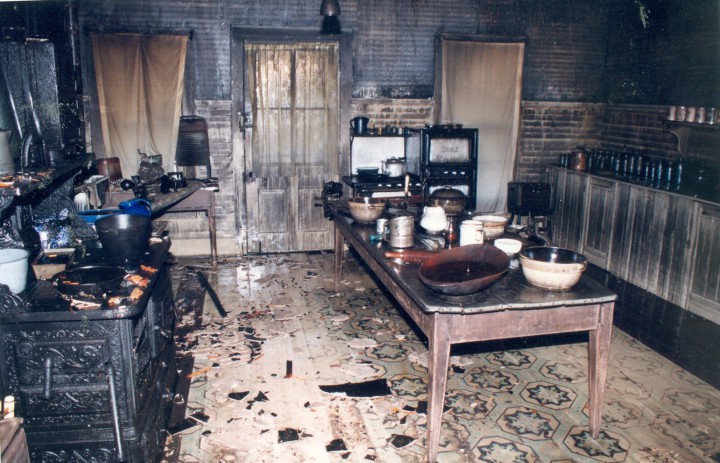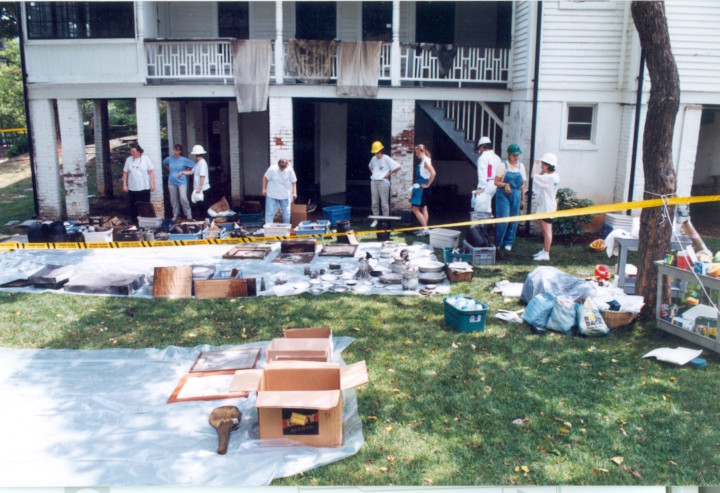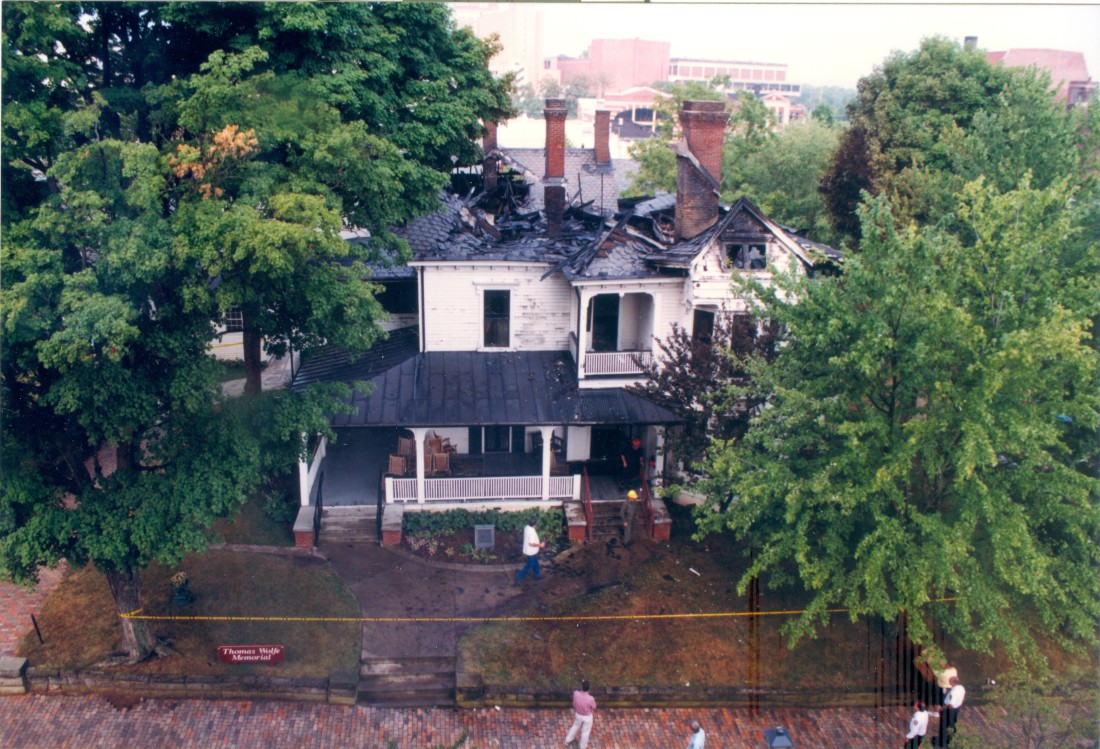Steve Hill was asleep when the phone rang in the early morning hours of July 24, 1998. Half-awake, he answered the call. An officer from the Asheville Fire Department was on the line. There was a fire at the Thomas Wolfe Memorial.
An Asheville native, Hill first began working at the memorial as an intern in spring 1978. Later that same year, he was hired as a staff member. By March 1979, he had taken over as site manager, the position he held on the night of the fire.
Hill asked the firefighter the extent of the damage. After a long pause, the officer replied, “You just better get downtown.”
The roof is on fire
July marks the 20-year anniversary of the unsolved arson that nearly destroyed one of Asheville’s historic landmarks. Built by Erwin Sluder in 1883, the domicile originally contained seven rooms. A subsequent owner transformed the abode into an 18-bedroom boardinghouse, later named the Old Kentucky Home.
By 1906, Julia Wolfe had taken over the establishment, eventually expanding the property to include 29 total rooms spread over 6,000 square feet. Years later, in 1929, her youngest son, Thomas Wolfe, immortalized the structure, his family and many of the city’s residents with the publication of his controversial debut novel, Look Homeward, Angel.
Some buildings work a strange magic in the lives of those who inhabit them; such was the influence of the Old Kentucky Home on the young author. “If Thomas Wolfe had grown up in a normal family, away from that house, I don’t know if he would have become the writer that he became,” remarks Hill.
That thought was on Hill’s mind as he hung up with the officer. It was a little after 3 a.m. when he made his way to the Old Kentucky Home. The city’s downtown streets were all but empty. Until, that is, he turned onto North Market Street. Firetrucks lined the historic site’s parking lot. By the time Hill stepped out of his car and turned the corner toward the property, he could see the building’s roof ablaze.
“That was my first impression,” he says, remembering the searing flames. “And I thought about how long the house had been there and what all it had endured and how much work we had all put into it to make it the historic site it had become. And I thought: All that history has come to an end.”
Six weeks shy
Julia Wolfe operated the Old Kentucky Home until her death in 1945. For the next four years, the property remained in the Wolfe family, before the Thomas Wolfe Memorial Association purchased it in February 1949. That summer the organization opened the site to visitors, offering guests an inside look at the boardinghouse known as Dixieland in Look Homeward, Angel.

Nearly a decade later, the city of Asheville took ownership of the property; the site became a state-run facility in 1976. Throughout these transitions, the home’s interior remained as it had been during Julia Wolfe’s lifetime. Original furniture, books, musical instruments and cooking utensils filled the rooms, transporting guests back to the early part of the 20th century.
Thoughts of those furnishings and artifacts flooded Hill’s consciousness as water hoses continued to pour down on the burning roof. Ironically, the memorial had been scheduled to shut down that September for repairs, among them the installation of a fire-detection system.
“We had already planned to have the furniture taken out,” Hill says. “And that just kept running through my head that night. I had six more weeks before all of it would have been out. … That’s something I’ve never gotten over. As hard as I worked on it, all that fell out from under me.”
One hell of a job
Originally, Thomas Wolfe had planned to title his debut novel O Lost. In the early hours of July 24, 1998, things certainly seemed that way. “By all rights, the house should have been on the ground,” says retired firefighter Buddy Duckett, who served as incident commander that night. “But we took some chances.”
Interior crews covered furniture with tarps and cut holes in the floor to drain excess water. By then, the fire, which started in the dining room, had made its way into the home’s walls. Unable to gain access to the roof, the interior crew retreated. Ladder towers took over and doused the structure’s exterior flames.
As incident commander, Duckett called the shots during the battle. The home’s significance, he notes, influenced his approach. Rather than fall back into a defensive mode, allowing the fire to consume the structure while crews worked to secure surrounding properties, his firefighters stayed on the offensive.
“Long story short, they did one hell of a job and got it put out,” says Duckett. “I was very proud of them.”
For firefighter Rodney Metcalf, who was a member of one of the first units to arrive that night, the fire remains among the more significant battles he’s fought in his 29-year career. “I was glad we were able to do what we did,” he says. “And that we were able to preserve as much stuff as we had. That was a good feeling.”
A wet, dark cave
By daylight, the community response was in full swing, according to Hill. Volunteers from across the city, region and state made their way to the Old Kentucky Home to sort through and organize recovered items. The Biltmore Estate, remembers Hill, “sent truck after truck after truck of supplies to the house.” With most of the property’s structure still intact — albeit badly damaged — the memorial would eventually restore 85 percent of its original inventory.

Jeff Futch, who is now the regional supervisor of the Western Office, was among the early arrivals that day. Beyond the initial shock over seeing the home’s mutilated roof, he remembers his subsequent surprise in discovering the amount of water dumped on the structure to put out the fire. Between the two elements, he says, the house was transformed “into a wet, dark cave.”
Later that morning, the staff of the Radison Hotel (now the Renaissance Asheville Hotel) invited members of the recovery team to view the top of the home from the hotel’s upper-level windows. “That was pretty shocking, too,” Futch recalls. “We didn’t realize until then how much the roof had collapsed. Looking down on the house like that was just another wave of, ‘Oh my goodness.’”
Preparing for the worst
Once the initial astonishment wore off, some of the same organizations that had joined forces to help recover the home’s salvageable items began discussions on disaster preparedness. “We realized we needed to up our game,” says Martha Battle Jackson, chief curator at the Division of State Historic Sites and Properties.
The following year, as a direct result of the fire, the Mountain Area Cultural Resources Emergency Network formed. Known as MACREN, the organization put on monthly workshops that covered topics from how to handle wet documents to creating stronger ties between historic sites and emergency management agencies. While the monthly sessions have since given way to yearly meetings, the early impact of the group remains evident. “We now have a disaster plan,” says Battle Jackson. “We have a trailer with disaster supplies and equipment that can hook up to a truck and be taken out at a moment’s notice.”
Similar networks have since formed across the state as a result of MACREN. These include the Triangle Area Cultural Resources Emergency Network, as well as the statewide Cultural Resources Emergency Support Team.
“The creation of MACREN certainly made people more aware of the importance of a network,” says Futch.
In the shadow of the hulk
Six years would pass before the restoration of the Old Kentucky Home was complete. The first four were spent negotiating insurance claims, raising money and coming up with architectural plans. The next two years saw the roof replaced, the two destroyed rooms rebuilt and the remaining sections of the house restored.
“I had some people say, ‘Well, that must have been the easiest six years of your life while it was closed,’” remembers Hill. “The truth of the matter is I experienced more anxiety and worry and sweat equity in those six years than I’ve ever put into anything before in my entire life.”
Throughout the multiyear project, tours of the home’s exterior went on. The staff also held educational programs inside the memorial’s visitor center. Meanwhile, donations came in from around the country. The overall restoration would cost $2.4 million. Insurance covered all but $300,000.
During that period, Hill says the shock of the fire never wore off. “Just to come in every morning and to sit in the shadow of the hulk of that house was hard,” he notes. Harder still was to put the project aside at the end of each day. Hill remembers nights spent in his basement scrubbing and polishing door knobs and hinges from the Old Kentucky Home. “That was my way of adding something back to it as far as the physical labor part of it,” he says. “Even if it was just cleaning hardware.”
Soaking it all in
When Battle Jackson first arrived to Asheville by way of Raleigh in the immediate aftermath of the fire, she cried. When, a few years later, she saw footage of the blaze for the first time, she cried again. Six years after the inferno, as the restored Wolfe family furniture was placed back inside the home’s 29 rooms, she cried over the house for a third time. “I just couldn’t believe how good it looked,” she says.

For Futch, the memory of the fire still lingers. “Every time I drive over there, I’m reminded of it,” he says. Even on sunny days he’ll sometimes stand on the property’s front porch and imagine “the black cave with water dripping all over the place.”
Meanwhile, Hill, who retired in 2011, says the fire remains the most painful period of his 35-year tenure at the memorial. “You hate for something like that to have happened when you were responsible for the house,” he says. “That’s one element I’ve really never gotten over. That it happened during my watch.”
Still, the near-catastrophe brought with it occasional glimpses of pride and pleasure for the site manager. The museum-quality restoration meant each item in the house was replaced, like for like. The slate roof, for example, was not simply swapped for concrete slabs. Such decisions added to the overall cost, but contributed to the integrity and mission of the restoration. “We had to stick to our guns and demand that things be done in a responsible way that would honor the history of the house,” Hill explains.
Moments of unforgettable connections also arose in the wake of the fire. Hill recalls a fundraiser hosted by writers Pat Conroy and Wilma Dykeman. Afterward, Hill returned to the memorial. He had his back to the visitor center, his eyes locked in on the damaged home. “I thought I was alone,” he says. “Then I heard this voice say, ‘Don’t worry about it, it’s all going to be okay.’ And it was Pat. It was one of those things where you felt like crying: to have someone like Pat Conroy offering you encouragement.”
And then there was the grand reopening of the Old Kentucky Home itself, which took place on Memorial Day Weekend in 2004. “I remember at the close of the day everybody else went home and I just sat in the middle of that house, with all the furniture back in and the freshly painted walls and repaired ceilings and everything,” Hill says. “I sat there for I don’t know how long, it must have been several hours, just soaking it all in.”
Editor’s note: Thomas Calder leads occasional tours at the Thomas Wolfe Memorial.



Never forgot that day…Ed Smathers and I had to drive that morning to Fort Bragg to pick up some office furniture and weapons racks for our Reserve unit in Brevard. On the way down we heard about the fire at the Wolfe homeplace on the radio, on the way back we heard that 2 National Capitol police officers had been shot and killed inside the US Capitol Building in Washington. And when we got to Statesville, we got detoured thru the country because a fuel tanker truck had hit the Interstate overpass bridge at Valdese and burst into flames, and the intense fire caused the bridge to collapse, and I-40 was closed. We didn’t get back to Brevard until near midnight. We sure enough thought that the planets had lined up wrong or something.
Hey Phillip. Hope you’re doing well. Thanks as always for sharing. I hope others will share their memories of that day, as well.